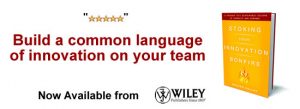How Product Managers & Innovators Look & Sound Like Leaders [podcast]

Have you noticed leaders in your organization sound and look different from other employees? It’s not always true for all organizations, but leaders often talk differently — they are optimistic when they speak, they ask insightful questions, and they tend to focus on what is most important.
To explore the topic of what leaders sound like – also known as, how to talk like a leader, I spoke with Tom Henschel, a professional actor who is now an executive coach. He works with clients primarily on achieving the look and sound of leadership. He’s a communication skills coach and has been running his company, Essential Communications, since 1990.
Before that, Tom got his start as a professional actor after attending The Juilliard School and going on to perform in over a hundred plays and episodes of television. He was also a successful director and university teacher.
He also has a monthly podcast, “The Look & Sound of Leadership,†which is a permanent member of the “What’s Hot†business podcast section on iTunes.
Here is a summary of the topics discussed and a link to the interview:
- [3:22:] How did your experience as an actor help to equip you as a communication coach? Behavior has meaning. When you raise an eyebrow or a fist when you are talking to someone, it has meaning. The person you’re talking to is going to have a reaction regardless what is in your heart to communicate. In the workplace people can forget that behavior has meaning. I call it acting on the corporate stage. Your audience is around you all the time. From acting I learned the importance of been intentional – understanding your intentions in a scene. The same applies to the corporate environment. I often ask executives what their intentions are — for example, what they want from a meeting or a discussion. Behavior has meaning and your intentions need to be clear. This is especially true for product managers who often do not have any real authority and must use their influence to gain support from others.
- [7:04] What is the look and sound of leadership? It is the name of my podcast as well as the brand of my work. It is my coaching. It is simply the idea that your look and your sound has meaning and will impact your effectiveness. I’ll illustrate it with an example. Phil was a senior leader at an aerospace company. He was fantastic at having the look and sound of a leader. He was leading a billion dollar project. When I meet with Phil, I ask him what are we talking about today. He might respond with, “There are three things I want to talk about – a conversation with my boss, an issue about my staff meetings, and something with one of my direct reports.†That kind of sorting of information and clarity is a great way to sound like a leader. That is the look and sound of leadership. Some people are great at it and others are terrible. Product managers must communicate with others, especially leaders, in ways that make sense to the person they talk to, helping them understand the bigger picture. Sorting information like Phil does is a useful communication tool and part of looking and sounding like a leader. I call this tool Sorting and Labeling.
- [13:55] How do you use Sorting and Labeling? It involves four parts: (1) headline, (2) sort, (3) labels, and (4) transitions. An inforgraphic is available with the interview.
- The headline tells people what you are talking about. For example, “what I want to talk about is giving a successful presentation.†Pause after the headline to make it stand out as a headline.
- Next is sort, which usually means using numbers. For example, “I have one item we need a decision on …†or “ I have three items to discuss, first…â€
- Next are the labels for each item you wish to communicate. For example, Phil used the labels of a conversation with his boss, staff meetings, and a direct report. They are just labels to organize the communication. Don’t add detail to the labels — detail comes in the discussion.
- Finally are the transition statements. These help you to clearly communicate which items you’re currently addressing. As you discuss, refer back to the labels and sorting you provided. For example, “Let’s continue discussing item 2, improving our staff meetings.†This helps to keep everyone you’re communicating with focused on the current topic and the communication well-organized to accomplish your intentions.
 Listen to the interview with Tom Henschel on The Everyday Innovator Podcast for product managers and innovators.
Listen to the interview with Tom Henschel on The Everyday Innovator Podcast for product managers and innovators.
Wait! Before you go…
Choose how you want the latest innovation content delivered to you:
- Daily — RSS Feed — Email — Twitter — Facebook — Linkedin Today
- Weekly — Email Newsletter — Free Magazine — Linkedin Group
 Chad McAllister, PhD. is a product innovation guide, innovation management educator, and recovering engineer. He leads Product Innovation Educators, which trains product managers to create products customers love. He also hosts The Everyday Innovator weekly podcast, sharing knowledge from innovation thought leaders and practitioners. Follow @ChadMcAllister
Chad McAllister, PhD. is a product innovation guide, innovation management educator, and recovering engineer. He leads Product Innovation Educators, which trains product managers to create products customers love. He also hosts The Everyday Innovator weekly podcast, sharing knowledge from innovation thought leaders and practitioners. Follow @ChadMcAllister
NEVER MISS ANOTHER NEWSLETTER!
LATEST BLOGS
Starbucks and Big Tobacco
Back in the 1950’s smoking was glamorous, and just about everybody who was anybody smoked cigarettes. Then came the discovery, to the shock of millions, that sucking smoke into your lungs might not be good for you. Then came another revelation that one of the substances in tobacco, nicotine, which was used as a poison by the Egyptians during the times of the Great Pyramids, is addictive. People then began a mass exodus from the consumption of nicotine via inhaled smoke.
Read MoreWal-Mart Goes Green – What about your company?
With the price of gas above $3.00, some companies (and hopefully all) are beginning to look at the fuel efficiency of their fleets. Wal-Mart is the most public example of this with its trucking fleet. Its efforts include:
Read More



